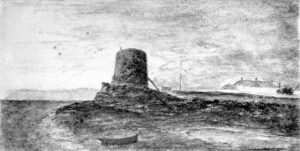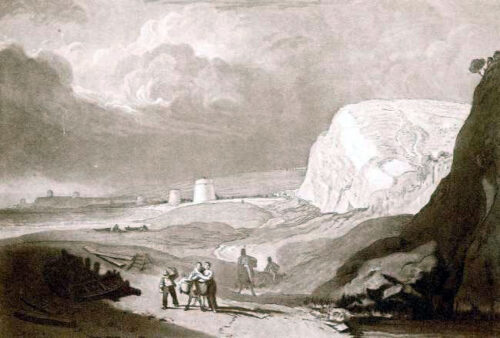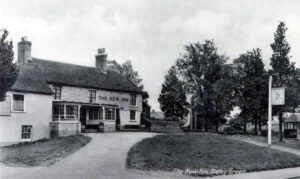
Goods such as tea, brandy, gin, tobacco and luxury goods were smuggled into this country during the 18th and early 19th centuries. High import duties were imposed to finance wars with America and France and not relaxed until after 1840. This, combined with a more effective Coastguard, ended widespread smuggling.
There are many local legends regarding ”smugglers’ tunnels” linking some of the older houses in the area or even leading down to the beach. The smugglers relied more on brute force and intimidation rather than stealth, so these stories are almost certainly untrue.
Smuggling was organised by gangs who planned the landings or ‘runs’. The Channel sailing smugglers brought the illicit cargoes across, while land-based smugglers took charge of the cargoes on or close to shore and were responsible for getting them to London for sale.
When a cargo of smuggled goods was landed, the ‘tubmen’ carried it up the beach, protected by ‘batsmen’ wielding wooden clubs or sometimes swords, pistols and muskets. A farm labourer could usually earn no more than 7 to 8 shillings a week but might make as much as 10 shillings for a night’s work as a tubman.

At that time the coastline and adjacent marshes were wild places and local knowledge would have been required to move about quickly and safely. The government used dragoons, who were soldiers on horseback, to try to hunt down the smugglers.
Martello Towers were built along this coastline from 1804. They were intended to prevent a French invasion but were also used by the Coastal Blockade to stop smuggling. Most of Bexhill’s towers have either fallen into the sea or been demolished. The only surviving tower in the borough is Number 55 at Normans Bay. From 1804 to 1814 the King’s German Legion was stationed in Bexhill and one of these Hanoverian soldiers was murdered at Little Common in 1804. Perhaps he had crossed the path of the local smugglers
The best known of the local smugglers were in the Little Common Gang. It was run by George Gillham and involved many other local families. Two boats were maintained for smuggling operations; ‘The Long Boat’ and the ‘Princess Charlotte’ which were moored at a placed called ‘Willow Tot’ probably near The Star Inn at Normans Bay.
The smugglers kept detailed accounts in order to manage their illegal trade and the Gillham account book still survives. It is believed that there was also one kept by the Pocock family although its whereabouts now are unknown.
The Battle of Sidley Green took place on 3rd January 1828. A consignment of contraband was landed on the beach where De La Warr Parade now stands. The Coastal Blockade manning the Martello Tower on Galley Hill spotted the smugglers but being outnumbered were unable to stop them. The smugglers took their cargo up Sea Lane, now Sea Road, and an eyewitness later recalled that one wounded smuggler and a cartload of goods was taken into the yard of the Belle Inn. The Blockade men caught up with the smugglers at Sidley Green. The battle cost the lives of three men. Eight captured smugglers were later transported to Australia. The rest of the smugglers escaped with their illegal goods.


